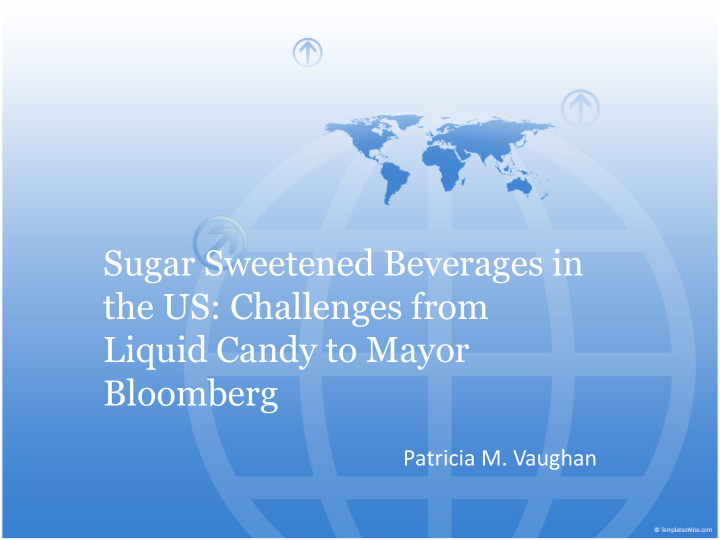



Sugar Sweetened Beverages in the US: Challenges from Liquid Candy to Mayor Bloomberg Patricia M. Vaughan
Liquid Candy : 1998 Published by CSPI Claims: SSB’s provide youth and young adults w/ too much sugar and calories SSB’s linked to obesity, heart disease and other nutritional problems Recommendations: More involvement from government at all levels No soft drink sales in schools No advertising to children and adolescents
So What Happened Next?
Beverage Industry Became a Target Lawmakers Beverage Industry NGO Groups Science Activist Community
Activists Driving Policy Debate Scientist Public Interest Groups Mainstream Laws & Programs
Public Doesn’t Support A Soda Tax In general, would you say you favor or oppose a new tax on soft drinks and juice drinks? 26% 70% / Oppose Favor Would you favor or oppose a new federal tax on soft drinks and juice drinks to pay for health insurance coverage for the uninsured as part of national healthcare reform? 44% 53% / Oppose Favor
Our Strategy Better Way Solutions School Beverage Guidelines Clear on Calories Political Outreach Science Pipeline Consumer Support
We Changed the School Landscape 90% fewer calories shipped 97% decline full-cal soft drinks 98% schools compliant
We Changed the School Landscape Product Mix in High Schools Product Mix in High Schools 2004 2010-11 Other Full Calorie CSDs (<66 Calories) 6% 3% Other (>66 Calories) Other 6% (<66 Calories) 13% Other (>66 Calories) Diet CSDs 20% 19% Full Calorie CSDs 44% Compliant Beverage Companies’ Share 100% Juices Water 5% of Sales Revenues 13% Water 38% Regular Sports Drinks 14% Schools’ Share of Regular Sports Drinks Diet Sales Revenues 12% CSDs 7% Compliant 100% Juices 2%
Alliance for a Healthier Generation School Beverage Guidelines “I applaud the beverage • Click to edit Master text styl industry for working with us, – Second level and for the good faith and aggressiveness they’ve shown in • Third level implementing these guidelines – Fourth level across the country. ” » Fifth level - Former President Bill Clinton at March 8, 2010 press conference
2010: Clear on Calories Introduced In support of First Lady Michelle Obama’s initiative to combat childhood obesity, the beverage industry made a voluntary commitment to make calories in our products clearer and more consumer-friendly by placing the information on the front of all packages , vending machines , and fountain machines . • Click to edit Master te – Second level
Political Outreach Grassroots Campaigns Meeting w/ Legislators Coalitions
2010: Consumers still don’t support a soda tax “National Poll Finds 56% of American Oppose Taxes on Soft Drinks” June 2, 2010 — “56% Oppose ‘Sin Taxes’ on Junk Food and Soft Drinks ” March 19, 2010 — Rasmussen Reports
NYC Soda Ban Mayor Bloomberg Proposed Portion Size Ban Over 16 oz. Applies to All Sugar Sweetened Beverages Subject to NYC Department of Health Jurisdiction Does Not Cover Beverages That Contain More Than 50% Milk by Volume Industry Challenged Ban in State Court Trial Court Overturned Ban; City has Appealed
Delivering on Our Commitments School Beverage Guidelines Calories Count Marketing to Children ABA Foundation Jobs
School Beverage Guidelines
School Beverage Guidelines Results 2006: 45% fewer calories in schools 2008: 58% fewer calories in schools 2010: 88% fewer calories in schools 2012: 90% fewer calories in schools
Calories Count “In support of initiatives to promote healthy, balanced lifestyles, and combat obesity, America’s leading beverage companies have developed a vending machine program that provides clear calorie information, encourages lower-calorie beverage choices, and reminds consumers that “calories count” in all the choices they make.”
• Click to edit Master text styles – Second level • Third level – Fourth level “$272,500 to 20 different community » Fifth level organizations nationwide”
Recommend
More recommend